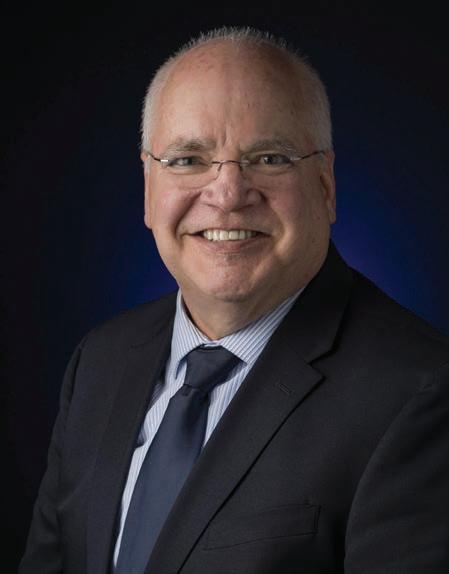
4 minute read
Dennis Andrucyk: Nurturing Diversity to Deliver the Future, on Schedule
Goddard’s newest center director, Dennis Andrucyk, has a reputation for fostering engineering excellence and workforce diversity. To him, the two are inseparable and crucial to realizing NASA’s goals of exploring the universe.
“In science we don’t build the same thing over and over again,” Andrucyk said. “So, it’s a diversity of ideas that helps make future science missions happen, and the diversity of ideas really needs to come from a diverse population of personnel in executing these directions.”
Andrucyk took the helm in January 2020 after serving as deputy associate administrator for NASA’s Science Mission Directorate. Before that, he was both NASA’s acting chief technologist as well as Goddard’s chief technologist. He also served as head of Goddard’s Engineering and Technology Directorate, among other roles. Through it all, he has championed and supported NASA’s diversity and inclusion efforts.
Andrucyk spoke with the CuttingEdge about how these passions informed his vision for the center, and on Goddard’s role in supporting space exploration.
How is Goddard positioned to advance NASA’s exploration and science goals?
Goddard is one of the biggest NASA centers, and we have a diverse set of capabilities that serve many NASA goals. If you look at the mission directorates at NASA Headquarters — Human Exploration and Operations, Science, Space Technology, and Aerospace Research — Goddard is wellpositioned in three of the four; we don’t do much in aeronautics.
When it comes to human exploration — that is, in Artemis and putting the first woman and the next man on the surface of the moon in 2024 and beyond — we have a significant footprint providing the communications capability. We have some heliophysics instruments going on Gateway to study space weather, which might affect astronauts. We’ve developed tools for servicing, and we’ve put scientific instruments on the International Space Station.
When I think about the science portfolio, which is truly Goddard’s bread and butter, we have the largest footprint of scientists anywhere in the world. Technology is the key r edit: NASA piece in making science happen. Goddard is very well-positioned, with its Photo C cadre of technologists, IRAD (Internal Research and Development) funding, and new capabilities supported by NASA’s Space Technology Mission Directorate. We have a great portfolio that leverages the past while looking toward the future.
What trends do you see that could affect research and development at NASA?
Some of the things that we have been pursuing in the past, like optical communications, show the way. We just finished putting together the Laser Communications Relay Demonstration, and optical communications and high-data-rate communications support constellation architectures: multiple spacecraft doing single observations. Constellations are going to be key in the future, as are autonomous systems that use machine learning to support science and mission planning and make them more cost-effective and efficient.
We’re also looking at new cryogenic technologies for future space telescopes. We’re seeing more and more capabilities come out of Wallops, particularly in the areas of suborbital missions that cost-effectively demonstrate technology on aircraft, sounding rockets, and balloons.
How will you support those seeking to ensure equal access and opportunities at Goddard?
For eight years before I left Goddard, I championed the African Americans Advisory Committee. It was a very rewarding experience, and one that made me a true believer in supporting other advisory councils.
Diversity in thought and ideas is what makes future science happen. We need everyone to come up with new concepts, new technologies, and new capabilities that don’t come from one mindset.
More than just race and national origin, diversity includes veterans, new and early-career employees, and first-line supervisors. It means making sure everyone is included in what we do and how we do it. It’s encouraging people to realize that supporting these advisory committees, and their activities, is part of our jobs. I want people to feel included. I want people to feel safe.
What new directions or initiatives do you see for Goddard?
When I came on board, I had three priorities: meeting our commitments, focusing on the future, and developing our people.
In the past, Goddard has been extremely successful at meeting our technical and scientific goals, but we haven’t always focused on cost and schedule. In the smaller and mid-size missions, we’ve done very well; however, on the flagships, where there’s a lot of new technology and new capability, schedule and cost are things we could focus on more. As we look to the future, I’d like us to be successful in all three: schedule, cost, and technical performance.
The point of focusing on the future is to be competitive in our new science capabilities and in supporting Artemis. I’m excited about our role in human spaceflight. I’m excited about being able to manage constellations more efficiently and effectively and showing interoperability in new technologies. I’m excited about competing well in new science opportunities.
And finally, it’s about the people. They are at the heart of what we do. I believe we can support current employees and bring in new folks, training them for future leadership positions.
So, Goddard is a place where people can grow their careers as well as their missions?
I’ve been doing It for three-plus decades, and yes.






